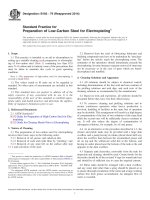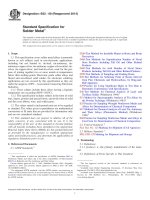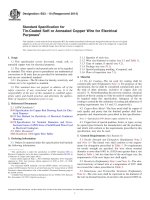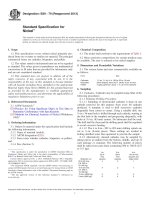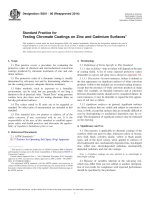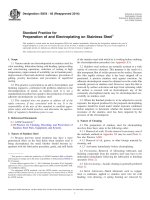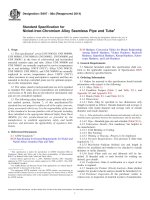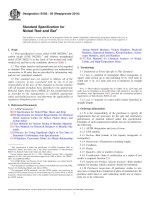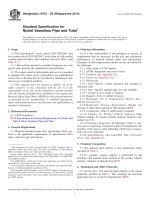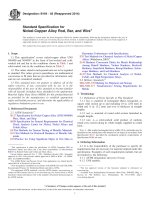Astm b 183 79 (2014)
Bạn đang xem bản rút gọn của tài liệu. Xem và tải ngay bản đầy đủ của tài liệu tại đây (75.48 KB, 3 trang )
Designation: B183 − 79 (Reapproved 2014)
Standard Practice for
Preparation of Low-Carbon Steel for Electroplating1
This standard is issued under the fixed designation B183; the number immediately following the designation indicates the year of
original adoption or, in the case of revision, the year of last revision. A number in parentheses indicates the year of last reapproval. A
superscript epsilon (´) indicates an editorial change since the last revision or reapproval.
This standard has been approved for use by agencies of the U.S. Department of Defense.
1. Scope
1.1 This practice is intended as an aid to electroplaters in
setting up a suitable cleaning cycle preparatory to electroplating of low-carbon steel (Note 1) containing less than 0.35
mass % of carbon and to indicate some of the precautions that
must be taken to maintain this cycle in good operating
condition.
3.2 Removal from the steel of fabricating lubricants and
finishing compounds may have to be undertaken by “precleaning” before the articles reach the electroplating room. The
remainder of the operations should immediately precede the
electroplating. In some instances separate removal of smut may
not be necessary as in the case of parts which are barrelelectroplated and tumbled.
NOTE 1—The preparation of high-carbon steel for electroplating is
covered in Guide B242.
4. Cleaning Solutions and Apparatus
1.2 The values stated in SI units are to be regarded as
standard. No other units of measurement are included in this
standard.
1.3 This standard does not purport to address all of the
safety concerns, if any, associated with its use. It is the
responsibility of the user of this standard to establish appropriate safety and health practices and determine the applicability of regulatory limitations prior to use.
4.1 All solutions should be subject to chemical control,
including determinations of the free acid and iron contents of
the pickling solutions and acid dips, and such tests of the
cleaning solutions as recommended by the manufacturer.
4.2 Based on tests and experience, all solutions should be
discarded before they have lost their effectiveness.
4.3 To conserve cleaning and pickling solutions and to
ensure continuous operation when heavy production is
involved, doubling of facilities in the same line of operation
may be desirable. This arrangement will result in a high degree
of contamination of the first of two solutions of the same kind
while the second ones will be sufficiently clean to continue to
use. It will also reduce the degree of contamination of
subsequent solutions, for example, by oil and grease.
2. Referenced Documents
2.1 ASTM Standards:2
B242 Guide for Preparation of High-Carbon Steel for Electroplating
B322 Guide for Cleaning Metals Prior to Electroplating
3. Nature of Cleaning
4.4 As an alternative to the procedure described in 4.3, the
cleaner and pickle tanks may be provided with a large dam
overflow and a pump having its intake placed about half-way
down the overflow dam between the accumulated grease and
oil on top and the settled-out solid dirt at the bottom, and
having its outlet placed near the bottom of the tank at the end
opposite to the dam overflow.
3.1 The preparation of low-carbon steel for electroplating
involves three basic steps in the following order:
3.1.1 Removal of oil, grease, and caked-on dirt,
3.1.2 Removal of scale and oxide films by “pickling,” and
3.1.3 Removal of any smut left on the surface after step
3.1.2 and activation of the steel.
4.5 Separate tank electrodes, removable from the tank for
inspection and cleaning, should be used. Contact hooks for the
electrodes should be of the inverted V-type for round tank bars
and should be of sufficient size to carry the required current.
1
This practice is under the jurisdiction of ASTM Committee B08 on Metallic
and Inorganic Coatingsand is the direct responsibility of Subcommittee B08.02 on
Pre Treatment.
Current edition approved Nov. 1, 2014. Published November 2014. Originally
approved in 1943. Last previous edition approved in 2009 as B183 – 79(2009). DOI:
10.1520/B0183-79R14.
2
For referenced ASTM standards, visit the ASTM website, www.astm.org, or
contact ASTM Customer Service at For Annual Book of ASTM
Standards volume information, refer to the standard’s Document Summary page on
the ASTM website.
4.6 Rinse tanks should be arranged with a dam overflow,
and any water inlet other than a spray should be placed so as
to ensure thorough circulation of the water and a large working
surface free from grease accumulation. An adequate flow of
water is essential.
Copyright © ASTM International, 100 Barr Harbor Drive, PO Box C700, West Conshohocken, PA 19428-2959. United States
1
B183 − 79 (2014)
4.7 Heating coils should be placed on the work-piece side of
the tank in order to assure a working surface free from grease
accumulation.
When using this method it must be followed by a water rinse
(5.4), an acid dip (5.5), and water rinse (5.4).
5.7 Water Rinse—Rinse the part again, as described in 5.4
but in a separate tank.
5. Procedure for Racked Parts
5.1 The cycle described in 5.2 to 5.6 should be used for the
preparation of racked parts subsequently electroplated in still
tanks, agitated tanks, semi- and full-automatic equipment,
except in those cases described in Section 6.
6. Variations in Procedure for Racked Parts
6.1 Consideration should be given to separate precleaning
between manufacturing operations; for example, between gearcutting and deburring operations, and between drawing or
stamping and buffing operations.
5.2 Precleaning—In general, it is necessary to remove
fabricating lubricants, buffing compounds, and other soils by
precleaning. This precleaning may be accomplished with
alkaline soak cleaners, cleaners designed to remove buffing
compounds (including the use of ultrasonic cleaners), alkaline
spray cleaners, and the use of chlorinated solvents such as
trichloroethylene and perchloroethylene in vapor-type degreasing equipment, or by use of cold chlorinated solvents if vapor
equipment is not available. Precleaning normally should be
accomplished as soon as possible after fabrication because
many stamping lubricants and buffing compounds become
much more difficult to remove if allowed to age on the steel
surface and can chemically attack the substrate causing etching.
6.2 Vapor phase degreasing with chlorinated solvents is an
excellent way to remove mineral oil form recesses such as
overlapping joints that cannot be cleaned by any other method.
6.3 Plants with limited facilities sometimes omit precleaning especially with work that is not too heavily soiled. This is
permissible; however, electrocleaning time may have to be
increased and it is almost always necessary to change electrocleaners more frequently. Likewise, close control is necessary
to ensure proper electrocleaner concentration at all times.
6.4 While pickling in strong hydrochloric acid or acid salts
in accordance with 5.5 is suitable for most oxide conditions,
including heavy annealing scale, welding marks, or wheel
burns, it may sometimes be preferable to use hot sulfuric acid
(about 100 mL of concentrated, 93 mass %, sulfuric acid
(density 1.83 g/mL) diluted to 1 L) containing a suitable
inhibitor to protect the steel from over pickling (see Warning
in 5.5). The acid temperature may vary between 50 and 70°C.
When inhibitors are used, a second alkaline cleaning operation,
preferably electrocleaning, should follow pickling to remove
any adsorbed inhibitor.
5.3 Electrocleaning—The part to be cleaned should be
anodically (reverse) electrocleaned in a solution of a suitably
compounded,
free-rinsing,
high-conductivity
steel
electrocleaner, at a concentration of about 45 to 90 g/L. The
current density should preferably be between 5 and 6 A/dm2
and the tank voltage about 6 V. The temperature should be
between 60 and 90°C. The time of cleaning following an
effective precleaning operation is usually between 1 and 4 min.
If proprietary cleaners are used, the recommendations of the
manufacturer should be followed.
6.5 Heavy scale may be removed more rapidly by making
the part to be pickled either anodic or cathodic in a 50 to 100
mL of concentrated, 93 mass %, sulfuric acid (density 1.83
g/mL) diluted to 1 L or proprietary acid salt solution at a
temperature of 50 to 65°C and an average current density of
about 4 A/dm2 (see Warning in 5.5). Anodic pickling avoids
hydrogen embrittlement. Cathodic pickling provides a brighter
surface provided the acid is not contaminated with heavy
metals such as copper, tin or lead.
5.4 Water Rinse—Immerse the part to be cleaned in clean,
overflowing water for a minimum of 15 s. If possible, air
agitation of the water rinse should be provided. If the water is
very cold, below 10°C, slight warming is beneficial. A fresh
water spray on the part as it enters and leaves the rinse tank
helps ensure complete rinsing.
5.5 Acid Pickling—Pickle the part in a solution of 150 to
500 mL of concentrated, 31 mass %, hydrochloric acid (density
1.16 g/mL) diluted to 1 L, 100 mL of concentrated, 93 mass %,
sulfuric acid (density 1.83 g/L) diluted to 1 L, or a solution of
proprietary acid salts at room temperature, for a sufficient
length of time to remove all oxides, rust, or scale. (Warning—
The acid should be added to the approximate amount of water
required and then after thorough mixing, diluted to exact
volume.)
6.6 In addition to acid pickling, scale may be removed by
shot-blasting, tumbling, or sandblasting. These methods avoid
hydrogen embrittlement but may work-harden the surface.
6.7 When there is a lapse of time between the final rinsing
operation (5.6) of the preparatory cleaning process and
electroplating, arrangements should be made for temporary
storage of parts. Those which are to be electroplated in a
cyanide solution may be stored in a solution of 15 to 30 g/L of
sodium cyanide and an equal amount of sodium hydroxide at
room temperature. Those which are to be electroplated in an
alkaline solution such as alkaline tin, should be stored in a
solution containing 8 g/L of sodium hydroxide at room
temperature. Storage time for parts to be nickel electroplated
should be minimized but, if necessary, they may be held in
clean cold water for a very short time (3 or 4 min, depending
on water quality).
5.6 Alkaline Descaling—In place of acid pickling (5.5) it is
sometimes found that alkaline descaling may be more practical. Such solutions are operated at about 40°C and average
current density of 2 to 5 A/dm2 . A typical bath composition
may be as follows:
Sodium hydroxide
Sodium cyanide
Chelating agent
(EDTA-NTA gluconates)
180 g /L
120 g/L
80 g/L
2
B183 − 79 (2014)
7.5 Water Rinse—Rinse the parts again as described in 7.3,
using a separate tank.
7. Procedure for Parts in Bulk
7.1 The cycle described in 7.2 to 7.5 should be used for
cleaning part to be electroplated in barrels, hand-operated or
automatic, except in those cases described in Section 8.
8. Variations in Procedure for Bulk Parts
8.1 Two water rinses after both cleaning and acid pickling
are beneficial in many barrel electroplating operations. This
serves to ensure more complete rinsing and thus prevent
carry-over of cleaners or acids into subsequent tanks.
7.2 Alkaline Cleaning—Clean the parts by tumbling with or
without current, in a solution of 30 to 60 g/L of a suitable
alkaline cleaner at 60 to 90°C. Anodic electrocleaning at about
2 to 4 A/dm2 may supplement tumbling for more effective
cleaning.
8.2 Heavily scaled parts such as heat-treated nuts and bolts
may require pickling in strong inhibited sulfuric acid (see 6.4).
Tumble-pickling is preferred to immersion-pickling in bulk
because the tumbling action increases the rate of scale and
oxide removal.
7.3 Water Rinse—Rinse the parts in clean, overflowing
water. Air agitation of the rinse water is beneficial. If the water
is very cold, rinsing is improved by some warming.
7.4 Acid Pickling—Pickle in a solution of 150 to 500 mL of
concentrated, 31 mass %, hydrochloric acid (density 1.16
g/mL) diluted to 1 L at room temperature. Other suitable
pickling solutions are proprietary acid salts and 50 to 150 mL
of concentrated, 93 mass %, sulfuric acid (density 1.83 g/mL)
diluted to 1 L (see Warning in 5.5).
8.3 Storage—If parts must be stored after cleaning and
pickling prior to electroplating, the procedure described in 6.7
should be followed.
NOTE 2—Additional information on procedures for cleaning of lowcarbon steel prior to electroplating may be found in Guide B322.
ASTM International takes no position respecting the validity of any patent rights asserted in connection with any item mentioned
in this standard. Users of this standard are expressly advised that determination of the validity of any such patent rights, and the risk
of infringement of such rights, are entirely their own responsibility.
This standard is subject to revision at any time by the responsible technical committee and must be reviewed every five years and
if not revised, either reapproved or withdrawn. Your comments are invited either for revision of this standard or for additional standards
and should be addressed to ASTM International Headquarters. Your comments will receive careful consideration at a meeting of the
responsible technical committee, which you may attend. If you feel that your comments have not received a fair hearing you should
make your views known to the ASTM Committee on Standards, at the address shown below.
This standard is copyrighted by ASTM International, 100 Barr Harbor Drive, PO Box C700, West Conshohocken, PA 19428-2959,
United States. Individual reprints (single or multiple copies) of this standard may be obtained by contacting ASTM at the above
address or at 610-832-9585 (phone), 610-832-9555 (fax), or (e-mail); or through the ASTM website
(www.astm.org). Permission rights to photocopy the standard may also be secured from the Copyright Clearance Center, 222
Rosewood Drive, Danvers, MA 01923, Tel: (978) 646-2600; />
3
